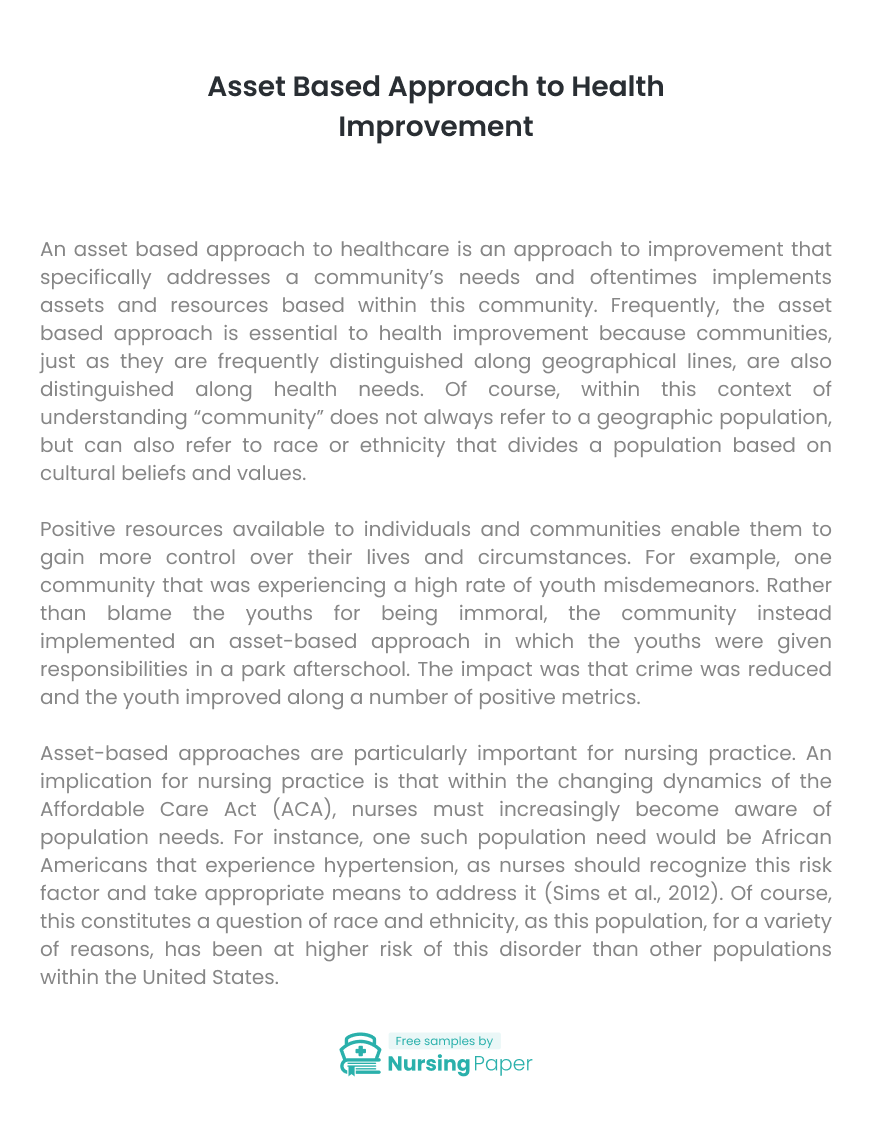
Asset Based Approach to Health Improvement
Introduction
An asset based approach to healthcare is an approach to improvement that specifically addresses a community’s needs and oftentimes implements assets and resources based within this community. Frequently, the asset based approach is essential to health improvement because communities, just as they are frequently distinguished along geographical lines, are also distinguished along health needs. Of course, within this context of understanding “community” does not always refer to a geographic population, but can also refer to race or ethnicity that divides a population based on cultural beliefs and values.
Positive resources available to individuals and communities enable them to gain more control over their lives and circumstances. For example, one community that was experiencing a high rate of youth misdemeanors. Rather than blame the youths for being immoral, the community instead implemented an asset-based approach in which the youths were given responsibilities in a park afterschool. The impact was that crime was reduced and the youth improved along a number of positive metrics.


Asset-based approaches are particularly important for nursing practice. An implication for nursing practice is that within the changing dynamics of the Affordable Care Act (ACA), nurses must increasingly become aware of population needs. For instance, one such population need would be African Americans that experience hypertension, as nurses should recognize this risk factor and take appropriate means to address it (Sims et al., 2012). Of course, this constitutes a question of race and ethnicity, as this population, for a variety of reasons, has been at higher risk of this disorder than other populations within the United States.
Another implication of the asset-based approach for nursing practice is that related to cultural aspects. In this respect, through recognizing the unique cultural elements and beliefs associated with a population can contribute to nurses being able to comprehensively address conditions related to this population in an effective and meaningful way. For example, Native American and Native Alaskans are among the cultural groups that – although small – have direct health needs associated with their conditions. Specifically, this population has a lower life expectancy than other Americans as well as much higher unemployment rates; these conditions can have a systematic impact on health issues within the group. In terms of belief systems, this population group places a high amount of emphasis on the connection between health and nature. Through recognizing these unique cultural beliefs and conditions, nurses are able to be more adept at addressing the negative conditions that this population faces.
Conclusion
Ultimately, the strength of the asset/community based approach to healthcare is that it allows community organizers and healthcare providers, particularly nurses, the ability to identify health needs on a community level that ensures that these conditions are able to address in a meaningful and comprehensive way. Because of the effectiveness of this approach, it’s necessary for nurses to become acquainted with methods of population analysis, including survey methods, that will allow them to gain community-wide insights to implement asset-based health improvement.

1. Sims, M., Diez-Roux, A. V., Dudley, A., Gebreab, S., Wyatt, S. B., Bruce, M. A., … & Taylor,
2. A. (2012). Perceived discrimination and hypertension among African Americans in the Jackson Heart Study. American Journal of Public Health, 102(S2), S258-S265.



The download will start shortly.

The download will start shortly.
 Subject:
Nursing
Subject:
Nursing  Number of pages: 4
Number of pages: 4  Subject:
Medicine
Subject:
Medicine  Number of pages: 3
Number of pages: 3  Subject:
Health and Social Care
Subject:
Health and Social Care  Number of pages: 2
Number of pages: 2  Subject:
Health and Social Care
Subject:
Health and Social Care  Number of pages: 1
Number of pages: 1  Subject:
Health and Social Care
Subject:
Health and Social Care  Number of pages: 9
Number of pages: 9  Subject:
Nursing
Subject:
Nursing  Subject:
Medicine
Subject:
Medicine  Number of pages: 2
Number of pages: 2  Subject:
Nursing
Subject:
Nursing  Number of pages: 3
Number of pages: 3  Subject:
Health and Social Care
Subject:
Health and Social Care  Number of pages: 5
Number of pages: 5  Subject:
Health and Social Care
Subject:
Health and Social Care  Number of pages: 6
Number of pages: 6  Subject:
Nursing
Subject:
Nursing  Number of pages: 2
Number of pages: 2  Subject:
Nursing
Subject:
Nursing  Number of pages: 7
Number of pages: 7  Subject:
Health and Social Care
Subject:
Health and Social Care  Number of pages: 20
Number of pages: 20  Subject:
Health and Social Care
Subject:
Health and Social Care  Number of pages: 3
Number of pages: 3  Subject:
Medicine
Subject:
Medicine  Number of pages: 5
Number of pages: 5 
